As prices started to show a monthly decline of 0.6% in December, the inflation rate fell from 5.9% to 5.4%, leading to the indexation expected by Statec to be postponed. According to the Luxembourg’s statistics bureau’s previsions, 2023 could however potentially witness 3 indexations, the first one of which during the first quarter of the year.
But what is the cost of indexation and who pays for it? According to Statec, who at the start of January spoke to l’Essentiel, indexation costs around €965m. The government pays €200m, the financial sector €175m and other industries and businesses €590m.
The Luxembourg Chamber of Commerce in 2022 , though a Statec representative told Delano: “The calculation is simple: you take the gross wage cost, and you add 2.5%. I don't know what basis the [chamber of commerce] used, but we took our last forecast, and the CoC probably didn’t have these figures. For the net, it’s more delicate, and our figures remain estimates.”
Of the €965m, €598m go to residents’ wages, therefore 62% of the total cost. The rest is attributed to cross-border workers. “Since the employment split is rather 50:50, the higher share of gross cost of a slice falling on residents is explained by the higher average wage cost of residents,” the Statec official said.
The higher the salary, the more it costs in terms of indexation too. While the smallest wages (€0-€3,100/household/month) cost €49m, the highest (over €8,700/household/month) costs about €212m per indexation.
